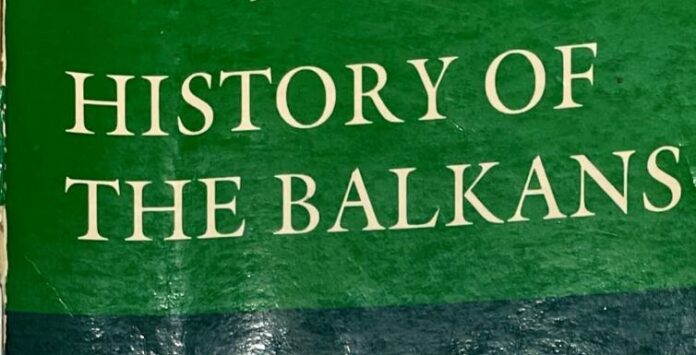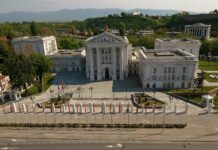The cover of the book of the same title, written by Barbara Jelavich used for illustration purposes only
How is history written in Kosovo? What do students and young people in Kosovo learn about the history of their country and that of the surrounding countries? What is the content of this “story”? Where is it based, if it is based anywhere? What impact does this lecture and discourse have on the creation and ripening of myths that are already layered in the Western Balkans region? Who benefits from creating these narratives that are not based on facts? How did they get to the point where almost all we learn is folklore and all we preach is folklorism?
All these questions may have answers; in fact, they certainly have answers. The real question is if the day will ever come that this trend will stop, that it will not be manipulated with a social science of such fundamental importance as history, and when the day will come that the facts will be interpreted correctly. I apologize here! Facts don’t need interpretation; myths do; fiction does. It’s that simple; facts just have to be told as they are; events are described; folklore and myths, on the other hand, as they are fictional, need metaphors, hyperbolization, and black-and-white interpretations to create the effects they were invented for in the first place.
The danger that the practice of written historiography based on myths fosters is not simply the discourse of untruth but also the continuation of the worsened inter-ethnic relationship and negative cultural phenomena in the Balkans. It is not possible to build interaction, much less harmony and peace, or, to put it in well-known diplomatic terms, inter-ethnic and regional stabilization, if we do not begin to look at ourselves, if we do not begin to reflect on who we are, what we have done, and what we have caused to others.
We, the young people of the Balkans, all we do on a daily basis is boast about who each of us is, having the background of what each academy of sciences writes about the citizens of the majority ethnic group in the respective state, doing this with excessive pomposity, never sparing the historical interpretations of this or that textbook by which we learned in school. This is best reflected in the most common interaction on the social network X (formerly Twitter) between the Albanians of Kosovo and the Serbs of Serbia, or between the Croats of Croatia and the Serbs of Serbia, and so on. This audience is over 90% (with a small margin of error) young.
The key problem of inaccurate and non-factual interpretation of history and events that took place even a few decades ago is best seen in the history textbooks from which students learn from the fifth grade of elementary school until the end of middle school.
Below, you can find just a few of the most typical examples of what is found in the history books of two of the countries where this phenomenon is most prevalent. What the history texts in the countries mentioned below have in common is that in these summaries, it has been very difficult to decide where to start when listing mis-interpretations of each. The omissions are greater than one can imagine, and the mistakes are even more scandalous.
KOSOVO
The publicist Shkëlzen Gashi, at the same time one of the most relevant in Kosovo on the content of history texts, told KTV that “it depends on what seems to be the biggest problem for someone. For someone, it may seem that the biggest problem is the presentation of the origin Albanians in these textbooks, but one might think the biggest problem is the presentation of the history of Kosovo within the framework of the Ottoman Empire, which in these texts is presented exclusively negatively as a dark period in which the Albanians have only suffered and have not recovered. That time was a time of rule, but not a time of five centuries of occupation, because when it lasts five centuries, it can no longer be called an occupation, especially when there is coexistence and when there is representation of Albanians in that system. Someone may find this period, the period from 1912 to 1999, when Kosovo was under Serbian, namely Yugoslav rule, to be a more problematic presentation,” said publicist Gashi.
Asked, among other things, specifically about the presentation of the last war in Kosovo in history textbooks, Gashi said: “The presentation of the last war in Kosovo does not contribute to reconciliation, on the contrary, it helps the separation or deepening of further division between Albanians and Serbs. There are some characteristics in the texts in Kosovo, but also in those in Serbia, in terms of the presentation of the last war in Kosovo. The presentation of the crimes—the crimes that took place in Kosovo during the years ’98–’99—is problematic because only the crimes committed by the Serbian forces are presented in Kosovan history textbooks, and these crimes are exaggerated, and in most cases, they are not quantified. The correct language is not used; a scientific language is not used, instead phrases that we can freely say are harmful to children’s mental health are used, especially considering the education system here that requires children to learn mechanically everything written in textbooks. For example, one of the phrases that describes the crimes that happened here is something like this: “Horrible scenes of barbarism by the bloodthirsty Serbian fascist squadrons.” It would be better to present these data correctly for these crimes that have occurred, referring to the Humanitarian Law Fund based in Belgrade, led by Natasha Kandić, or the Council for the Protection of Human Rights and Freedoms in Pristina. Both of these organizations have said that the death toll is somewhere around eight thousand innocent civilians killed by Serbian forces, while if we look at how it is presented in history textbooks for primary and secondary schools, it is somewhere around 20,000. Every year we reprint these texts in 30,000 copies, and every year we misinform our children. Crimes committed by individuals of KLA as Dick Marty’s report and Clint Williamson’s report say, KMDLNj itself and the Fund for Humanitarian Rights have said that Serbs and other minorities were killed in Kosovo and that their number is rounded to the 1000th. And it would be very correct to present these in our texts. These data are presented in the history texts of Serbia, but these are doubled, and the history texts of Serbia do the same as the history texts in Kosovo; they double the number of people killed. For me, it is quite okay that the texts in Kosovo and those in Serbia present the liberation, namely the occupation of Kosovo, differently, but it is not correct to distort the facts or not present them at all”, said Gashi among others.
The publicist and civil society activist said that young people should not be offered only black-and-white conclusions and that the failure to present facts has a harmful effect on students. Otherwise, they should be encouraged to develop critical thinking and debating skills.
“And I think it is very important to present the Albanian-Serbian collaborations that happened not only during the last war but throughout history, from perhaps the period of medieval Serbian rule, from 1355 onwards, until Kosovo came under the rule of the Ottoman Empire. In the last war, for example, all we learn in the history texts is that the Albanians are good, the Serbs are bad, and somehow Serbia is identified only with Milosevic, which I consider to be wrong. Of course, it is necessary to accurately portray the atrocities committed by Serbian forces against the Albanians, but it is also necessary to show that there were positive aspects to these Albanian-Serbian relations. For example, no one ever mentions that in 1989, when the Milosevic regime suppressed the autonomy of Kosovo, there were also Serbs who opposed this. And there were even Serbs in Kosovo who protested together with hundreds of Albanians against the removal of Kosovo’s autonomy. Or, for example, when the poisoning of students in 1990 in primary and secondary schools throughout the territory of Kosovo is explained, no one mentions that there were Serbs who reacted and said: yes, this happened, and the poison thrown in the yard of the “Elena Gjika” school in Pristina also arrived at the house of a Serbian woman who reacted and said; yes, this poisoning happened, and I received medical treatment because I lost consciousness from the poison that was thrown in the school”, said Gashi.
“Or, for example, no one mentions that during the year 1996–1997, during the massive citizen protests for the overthrow of Milosevic in Serbia, where hundreds of thousands of Serbian citizens took part, they dedicated a minute of silence for the death of an Albanian in prison from Serbian police torture. And lastly, it is very important to present the currents that have occurred, the political-military currents among the Albanians during the 90s, and not to present this entire movement of that time within an umbrella as an Albanian national movement. This is because this is the truth, and secondly, it is because this is how we develop critical thinking in students; we develop their research skills. If we take the last war as an example, here only the KLA is presented as an organization that fought for the liberation of Kosovo, which liberated Kosovo with the help of NATO, but it is not mentioned that in addition to the KLA there were two other military-political formations: the FARK, or the Armed Forces of the Republic of Kosovo, and the LKÇK, or the National Movement for the Liberation of Kosovo. They (the youth) shouldn’t be offered “ultimate truths” and learn them by heart, but debating skills should be encouraged”, said Gashi.
The authors of these texts in Kosovo, in addition to these one-sided interpretations, have not been able to be correct even with universally known facts such as the year of Bonaparte’s birthyear or the length of the Chinese wall. Nor has providing internationally recognized statistics been something they have done well.
SERBIA
Serbia stands much worse than Kosovo in (not) including facts and coherent factual reality in the history pages of its textbooks. Serbia is so bad in this aspect that it can be said that it holds the baton in the Balkans. While in Germany the crimes of the Holocaust are legislated to serve as a lesson of what must not be repeated again, in Serbia none of the crimes committed by the Serbian state against the peoples of other neighboring states are accepted, and it is even legislated that the occupying tendencies violent are appropriate. Aleksandra Letić from the Helsinki Committee for Human Rights expresses the following about this phenomenon:
A new generation of youngsters are thrilling to the idea of Serbian ultra-nationalism and there is little effort to pull them the other way, she says. “In Bosnia Herzegovina monuments are raised to the perpetrators, but the victims are neglected. We have only one official monument for the victims in Republika Srpska and that was built because of international pressure.”
“What is concerning is that those who are actually supporting war criminals, supporting the ideology of those who actually committed war crimes are young people born after the war,” says Letić. She adds the young generation should be the driving force for progress towards an open and democratic society, but is “deeply involved in nationalistic and chauvinistic behavior.”
The schools, she laments, do not teach what the war criminals did to get convicted. “Some of the history text books end before the peak of the Balkans conflict,” she complains in a response for VoA.
Dubravka Stojanović, professor of history at the University of Belgrade and one of the most “nailed” names in Serbia due to her criticism of how history is written in Serbia and in the surrounding countries, says that: “Both (Serbia and Croatia) these countries changed memory of the Second World War and constituted new memories of the 1990s wars, turning them both into factors of new instability in the suspended conflict of the Yugoslav peoples”.
Stojanović, when asked about the alternatives to teaching history to young people in order to avoid nationalist narratives of history teaching, expressed them as follows:
“Well, there are a few alternatives, one alternative is to study history through historical sources, to present the historical sources to the pupils and then to open the discussion and the other alternative for example is to put in a multi-perspective way: to put different narratives together talking about the same historical event so that we can compare, so that we can how the other sees the same thing and to see how the interpretation of history so very different”, said Stojanovic.
Additionally, Stojanović discussed the idea of reconciliation in the former Yugoslavia and how reaching a goal like interethnic reconciliation requires more than just signing agreements.
“Usually reconciliation, for example in the former Yugoslavia is just a political flossula, they were just using it as we’re going to reconcile and doing nothing about it, so I think that what we need is a serious and deep of knowing each other and knowing what our different notions about the past and present are so it’s not about signing contract and then yes we are going to reconciliate, no, no that’s not enough”, added Stojanovic.
According to Stojanović, it is a violation of human rights to deprive someone the true recognition of history by presenting history through nationalist narratives or denying them the recognition of factual historical events.
“The resolution on the right to know your history as a human right because in many parts of the world there are minorities there are states that are oppressed without having the knowledge of their own past and this is one of the kinds of oppression that we can find in the world today and its also very dangerous for the peace processes around the world”, said by ending the historian.
Written by: Hanmie Lohaj














